AI NPCs: The Future of Non-Playable Characters in Gaming
AI NPCs are reshaping how game characters behave. Instead of scripted lines, they remember choices, react to players, and evolve across play sessions. Learn how studios use AI to build living worlds and how custom NPC systems can be developed with Scrile AI.
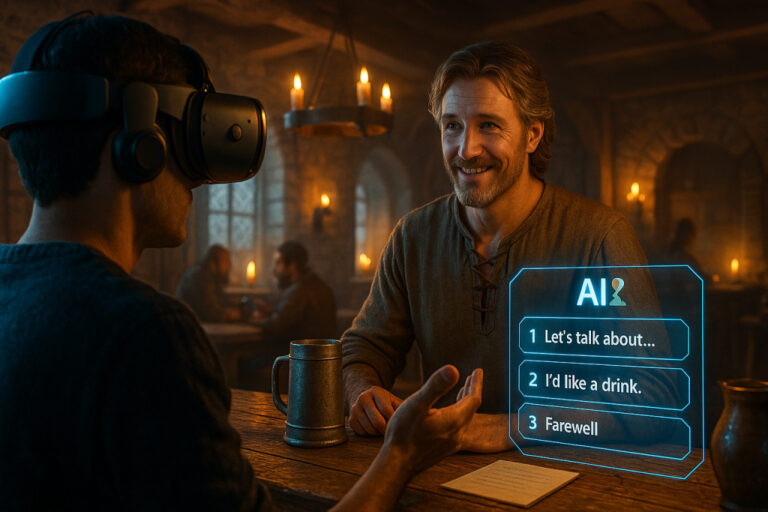
ai npcs
Games keep getting bigger, yet a lot of NPCs still feel like cardboard cutouts. You talk to them, they spit out the same two lines, and that’s pretty much the whole relationship. Lately, though, there’s a shift. Players are running into characters that remember what happened last session, bring up old decisions, or react in ways the script didn’t explicitly plan. That’s where AI NPCs come in—characters that behave less like props and more like people living in the same world as you.
Different studios approach this in their own way. Some plug language models into dialogue systems. Others build layered behavior rules so characters change based on mood, time, and what you’ve done to them. Instead of writing thousands of branching lines, developers focus on giving characters tools to generate their own reactions.
The interesting part isn’t just “better conversations.” When someone in a game gets angry with you and stays angry for the next five missions, the world feels like it’s actually moving forward. Players stick around because they want to see what these characters do next, not because there’s another quest marker.
This article breaks down how these systems work, which games already use them, and where developers might take things next.
What Makes a Character “AI” Instead of Scripted?
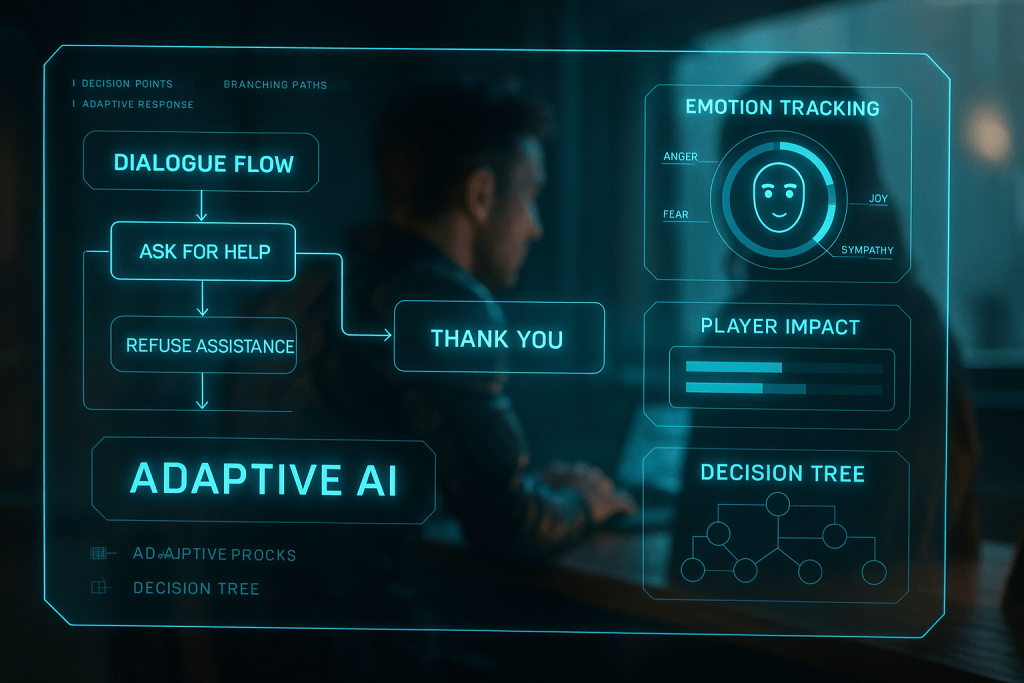
Most game characters aren’t dumb—they’re just stuck inside systems that never let them grow. They speak from a fixed script, run in circles, repeat idle animations, and pretend you don’t exist once the scene ends. An AI NPC works differently. Instead of following a pre-written tree, they react based on models that process player input, mood shifts, past encounters, and whatever else the designer decides to feed them.
So what is an AI NPC exactly? The simplest answer: it’s a character that responds to players using generated reasoning instead of a list of canned lines. The behavior isn’t random; it’s driven by rules, memory, and intent. A character might hold a grudge, get suspicious if you lie too often, or start acting helpful after seeing you save their faction three missions in a row. They’re more like autonomous agents than dialogue puppets.
This kind of design doesn’t replace writing; it changes what writing looks like. Instead of writing 500 lines of dialogue, writers define personality traits, boundaries, speech patterns, and knowledge the character is allowed to use. Think of it like building a brain instead of writing a speech.
How NPC Behavior Has Evolved
Old approach:
- Talk to NPC → they deliver a set line
- Maybe a quest unlocks, maybe not
- Player leaves, character forgets everything
Modern approach:
- NPC tracks past interactions
- Reactions shift as relationships form
- Player choices shape future conversations and behavior, not just quest paths
Three core traits define these modern systems:
- Adaptation: reactions shift based on player actions, not scripted triggers.
- Autonomy: characters decide how to behave inside defined rules instead of waiting for flags.
- Persistence: memory doesn’t reset when the player logs out.
None of this magically makes games smarter, but it opens doors. Worlds stop pretending and start responding.
Where AI NPCs Are Already Appearing
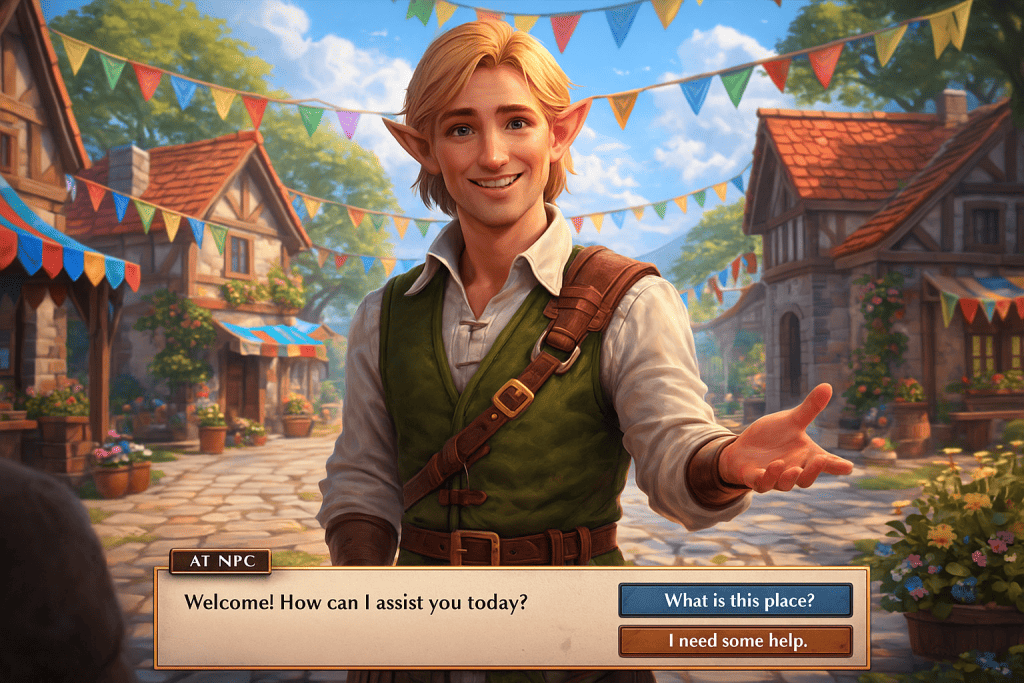
You don’t need to imagine some distant future to see AI-driven characters. They’re already slipping into real projects, both big-budget worlds and tiny experimental builds. Most aren’t fully autonomous yet, but you can see studios testing memory systems, dynamic dialogue, and characters that react to more than a single button press.
AI People is probably the clearest “let the world run itself” example. It’s built around autonomous citizens who walk, talk, argue, switch jobs, form relationships, and react based on what happened earlier in the session. You don’t trigger quests—they emerge because characters are doing their own thing and sometimes need help.
Inworld has been working with studios like Ubisoft and NetEase on prototypes where characters hold conversations using language models rather than pre-written lines. Think of a guard who remembers that you broke in last night and questions you instead of giving a generic bark.
Even traditional titles are experimenting with AI layers. Stalker-like survival mods, certain VRChat worlds, and some Unreal Engine demos at GDC have shown NPCs who form opinions over time. Not full personalities, but enough that they stop feeling like cardboard models.
Smaller teams are often braver than AAA studios. Indie projects built in Unity + Inworld, or even solo experiments shared on Itch.io, are letting villagers gossip about monsters they saw, or merchants raise prices if players steal too much. These games are rough around the edges, but they’re proving the core idea works.
This is where the phrase NPC AI starts to feel accurate—not just smarter pathfinding, but social behavior with memory.
What These Experiments Teach Us
Developers are learning fast, and patterns are emerging across very different games and prototypes.
- Stories come from interactions, not scripts. Saving a character changes future encounters instead of unlocking a cutscene.
- Reputation systems feel more personal. Instead of faction bars, characters respond based on long-term behavior they remember.
- Freedom comes with chaos. When everyone can “think,” developers spend half their time moderating conversations and debugging weird behavior.
- Voice + AI ≠ depth on its own. Players respond to consistency, not just auto-generated chat.
There are still problems: costs rise when simulations run server-side, moderation becomes mandatory, and not every player wants endless improv dialogue. But studios finally have tools to try new ideas instead of polishing the same quest tree for the hundredth time.
How AI Changes Gameplay, Not Just Dialogue
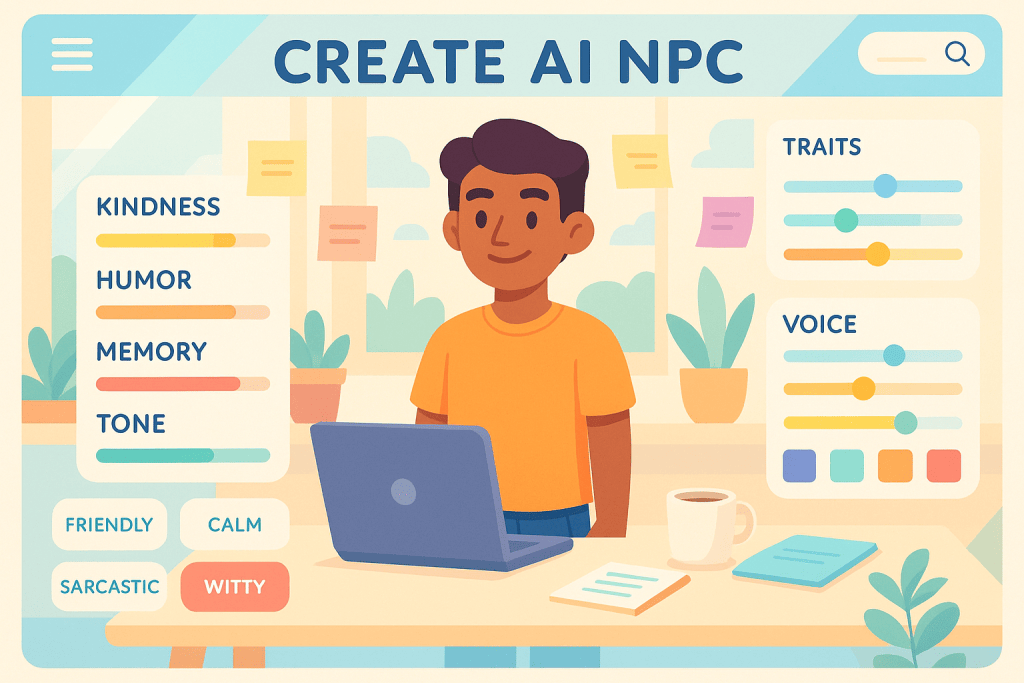
Players used to think of characters as static props—merchants standing in the same spot forever, guards repeating the same line, party members acting like memory-less robots. With AI NPCs, the rules start shifting. The world reacts long after the moment passes. A village remembers who helped rebuild the bridge. A rival keeps showing up because you humiliated them earlier. The game state stops resetting every time you reload.
This goes beyond talking. A shopkeeper raising prices because you robbed him isn’t “branching dialogue,” it’s systems connecting economics, trust, and social memory. This is the difference: behavior that follows internal logic, not a script.
Small example of how that might feel in play:
Old style
Guard: “Halt! State your business.” (Every time you walk by.)
AI-driven
Guard: “Back again? You left town in a hurry last night. People are talking.”
Then later:
“If you’re headed to the mines, take a lantern. That creature you fought is still out there.”
Same character. Different context. And if you ignore him? Maybe he stops offering help altogether.
Behavior Systems That Enable Depth
Before diving into mechanics, it helps to name what actually drives these reactions. Studios are experimenting with systems like:
- Memory graphs — characters store past interactions and pull them into future decisions.
- Personality models — traits shift reputation, aggression, friendship, loyalty.
- Emotion vectors — temp mood + long-term disposition affect tone and choices.
- Voice synthesis + animation pipelines — speech adapts dynamically, not stitched together.
These systems affect more than dialogue:
- Pacing feels less scripted, because events occur based on relationships, not triggers.
- Difficulty curves shift, since enemies adapt to tactics rather than just increasing stats.
- Replay value grows, because story beats remix instead of repeating.
- NPC factions evolve, even if the player stops interacting for a while.
Here’s a copy-ready table comparing classic NPC design to AI-driven versions:
| Aspect | Scripted NPCs | AI NPCs |
| Dialogue | Pre-written lines | Context-aware speech generated at runtime |
| Behavior | Triggered events | Autonomous reactions informed by memory |
| Player Impact | Linear progression | Persistent state that changes relationships |
| Development Cost | Heavy writing + quest logic | Compute, testing, moderation, system design |
These ideas aren’t hypothetical—prototypes like AI People, Inworld-powered demos, and modded RPG companions already show how one conversation can reshape several hours of play. When players come back to a world that remembers them, the relationship feels less like solving a puzzle and more like social storytelling.
Where Studios Earn Money With AI Characters
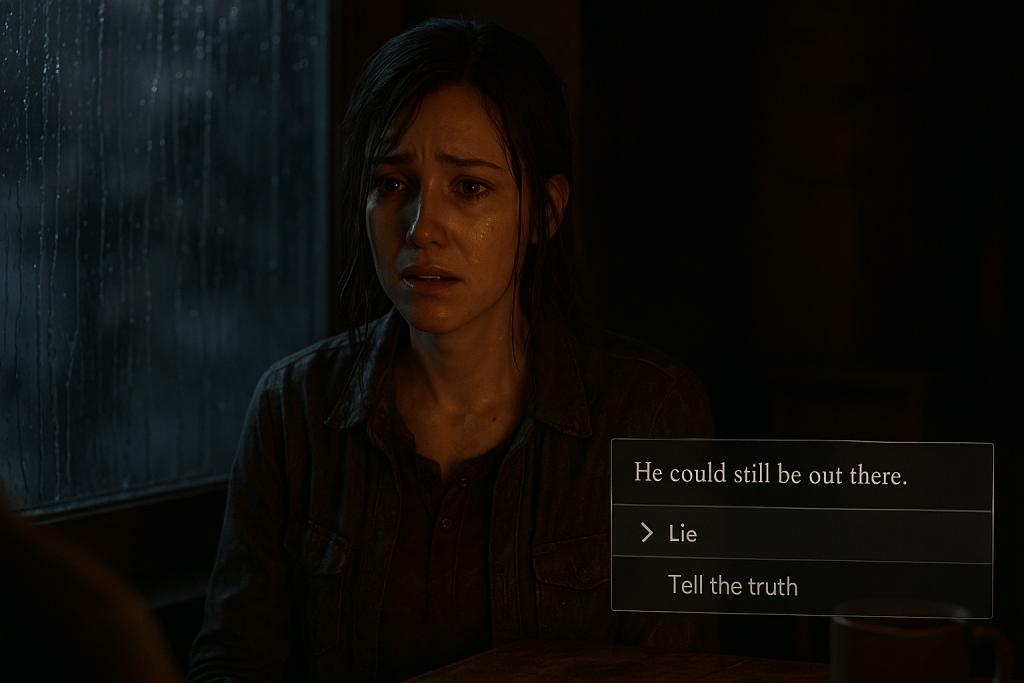
Once developers realize AI NPCs can evolve, remember players, and even create new story beats on their own, the next question is simple: how does this actually make money? Big publishers already see the potential, but smaller studios and modders can benefit just as much.
Some models are starting to take shape in both indie prototypes and AAA experiments. One direction involves AI-powered NPCs acting as living content pipelines—characters generating new dialogue, quests, and events without writers churning out hundreds of lines every patch. Another angle is personalization: a companion who remembers your play style and reacts to your achievements can feel more like a premium feature than a default asset.
Here are revenue paths emerging now:
- Paid character upgrades
Custom personalities, voice packs, emotional traits, lore expansions. - Personalized NPCs sold as DLC
Instead of generic quests, players buy a companion who learns alongside their playthrough. - Ongoing worlds with subscription logic
NPCs evolve over time—seasonal relationships, new factions, shifting alliances. - AI-driven shops and economies
Instead of fixed inventories, NPC merchants price items based on scarcity or your reputation. - Dynamic live events
Instead of static “weekly events,” NPC leaders trigger story arcs based on player behavior.
These models don’t replace traditional monetization—cosmetics, season passes, and expansions still matter. They add new layers on top of them. For small studios, this means they don’t have to write endless quest scripts just to keep players engaged. For big ones, it means a world that stays alive without constant manual content drops.
Build Custom AI Characters With Scrile AI

Most studios start with ready-made AI tools. They’re useful for experiments, but things change once a team wants deeper personality systems, memory, custom logic, or characters that fit the style of their world. This is where AI NPCs start becoming part of a game’s design rather than a tech demo.
Scrile AI builds systems like that as a development service. It’s not a marketplace or a boxed SDK. Instead, the team helps studios create their own models, dashboards, workflows, and hosting setups that fit their engine and genre. The work can start small—one companion character or a simple faction leader—and grow into a network of agents with shared memory or event triggers. The goal is to give studios control over how their characters behave instead of relying on generic presets.
What teams usually build with Scrile AI:
- NPC personalities with real memory
Characters change based on story progress, player trust, or past conversations. - Voice, chat, and behavior logic in one system
No juggling five different APIs to make a single merchant talk. - White-label dashboards for writers and designers
Update character personalities without rewriting code. - Integration with game engines and backend logic
Unreal, Unity, custom engines, web-based games, VR hubs.
These projects go beyond one-off bots. Some teams connect characters to real economies, guild systems, co-op story modes, or even creator communities where NPCs host events. Others want companions that travel across a player’s sessions instead of resetting every time a new patch drops.
From NPC Dialogue to Full AI-Driven Worlds
A single character can start the experiment, but worlds get interesting when multiple NPCs share context. One character can remember what another said. Factions track grudges. Merchants adjust prices. Relationships and story threads survive across playthroughs. Players come back because the world feels different each time.
Scrile AI helps studios build that foundation: their models, their data, their hosting, their branding. No dependency on someone else’s platform. The tools stay connected to the game, not the other way around.
Conclusion
Players want worlds that move even when they log off. They want characters who react like living residents, not quest markers waiting for the next trigger. AI NPCs push games toward that direction—more personality, more memory, more unexpected moments that feel like real interaction.
Studios experimenting with these systems don’t just add “smarter enemies.” They shape entire worlds where stories grow from play instead of pre-written paths. That kind of design needs tools built around the game, not generic presets.
If you’re ready to build characters that react, remember, and shape the story alongside your players, reach out to the Scrile AI team and see what you can create together.
FAQ
What is AI NPC?
They’re non-playable characters that react to player behavior through models, memory systems, and contextual dialogue instead of fixed dialogue trees. They can form relationships, remember actions, and change over time. Many studios use them for companions, shopkeepers, rivals, and background crowds.
Which game has AI NPCs?
Projects like AI People test fully autonomous characters that move, speak, and react without scripted lines. Other games use smaller pieces—behavior trees mixed with generative dialogue, or faction systems that shift based on player choices. Prototype builds in Unity and Unreal show how these systems spread into indie titles as well.
Will GTA 6 have AI NPCs?
Leaks and analyst expectations suggest more dynamic pedestrians, smarter police behavior, and systems reacting to events in real time. Nothing is confirmed publicly, but the idea fits Rockstar’s push toward bigger and more reactive open worlds.
